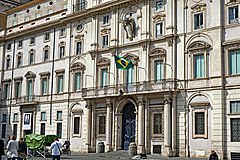Palazzo Pamphilj
| Palazzo Pamphilj | |
|---|---|

Palazzo Pamphilj, the Brazilian Embassy in Rome
|
|
| General information | |
| Town or city | Rome |
| Country | Italy |
| Construction started | 1644 |
| Design and construction | |
| Architect | Girolamo Rainaldi |
Palazzo Pamphilj, also spelled Palazzo Pamphili, is a palace facing onto the Piazza Navona in Rome. It was built between 1644 and 1650.
Since 1920 the palace has housed the Brazilian Embassy in Italy, and in October 1960 it became the property of the Federative Republic of Brazil in a purchase negotiation led by Ambassador Hugo Gouthier de Oliveira Gondim.
In 1644, Cardinal Giambattista Pamphilj of the powerful Pamphilj family, who already owned a palace between the Piazza Navona and the Via Pasquino, became Pope Innocent X. With this election came the desire for a larger more magnificent building to reflect his family’s increased prestige. Further land was bought, the architect Girolamo Rainaldi received the commission and construction began in 1646. The new project was to incorporate some existing buildings, including the former palace of the Pamphilj (whose decoration by Agostino Tassi was partially preserved) and the Palazzo Cibo.
In 1647, the Baroque architect Francesco Borromini was consulted about the design and he made a series of new proposals for the palace. However, the prevailing preference was for Rainaldi’s more staid and conservative design. Borromini’s limited contributions included the stucco decoration of the salone (the main room) and design of the Gallery, located at first floor level between the rest of the palace and the church of St. Agnese next door. The Gallery extends through the width of the block with a large Serliana window at either end.
Between 1651 and 1654, the painter Pietro da Cortona was commissioned to decorate the Gallery vault. His secular fresco cycle depicts scenes from the life of Aeneas, the legendary founder of Rome, as recounted by Virgil. The Pamphili claim to be descended from Aeneas. Unlike the large spacious volume of the Palazzo Barberini in which he had painted his fresco celebrating the reign of Innocent’s predecessor, Urban VIII Barberini, the Pamphilj Gallery was long with a low vault which meant that a single viewpoint to see the frescoes was not possible. So Cortona devised a series of scenes around a central painted framed ‘Apotheosis of Aeneas’ into the Olympian heavens. The elaborate doorframes regularly spaced along the longer walls of the Gallery display a combination of motifs typically used by Borromini and by Cortona
...
Wikipedia
